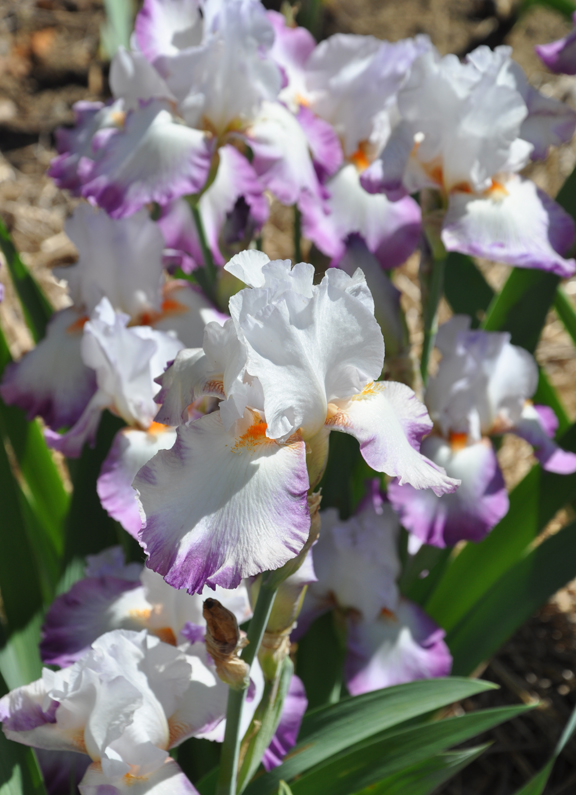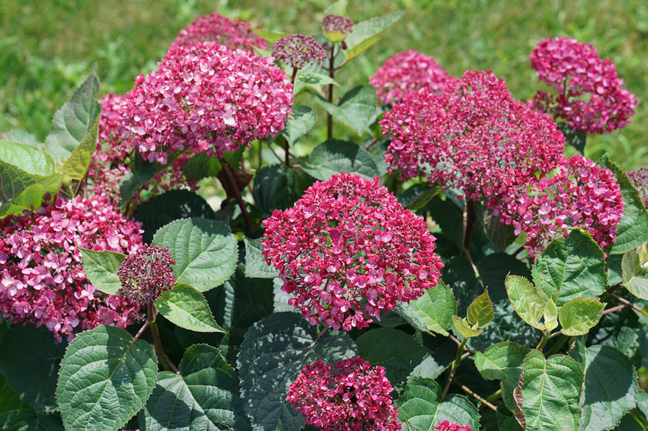Sadly, we are in the midst of yet another lockdown here in Ontario. I was surprised and a little relieved to discover that, despite the lockdown measures, nurseries and garden centers are open for a reduced number of shoppers. Plant shopping can finally begin so it's time to start drawing up a wishlist of some new plants along with a few old favourites.
If you're a fan of Gardener's World, you may remember Carol Klein wandering through a winter garden that showcased red and yellow dogwoods to perfection. I already have red and lime-green varieties, but I have yet to add a Dogwood with yellow stems. Dogwoods are one of the more shade-tolerant shrubs. They also adapt to a wide range of soil conditions. What also interests me about Artic Fire® 'Yellow' is spring flowers and the white berries that follow.
New for 2021 Red-Osier Dogwood, Cornus stolonifera Artic Fire® 'Yellow' is a deciduous shrub that has bright yellow stems that add winter interest to the garden. Arctic Fire® 'Yellow' has tiny, star-like, white flowers followed by white berries. Not available in Florida. Part shade to full sun. Height: 48-60 inches, Spread: 60-72 inches. USDA zones: 2-7
I saw this next Dogwood when I was scrolling through a wholesale nursery website. I couldn't decide if I liked the shape of the shrub, but I thought the foliage was really interesting. Pucker Up!® might be something I have to see in person before I decide if I like it enough to purchase a plant.
Red Twig Dogwood, Cornus stolonifera Pucker Up!® has heavily textured foliage. Though the stems have a reddish cast this shrub's defining characteristic is its foliage. Adaptable to a wide range of conditions. No flowers. Slow growing so it rarely requires pruning. Not available in Florida. Part sun to full sun. Height: 36-48 inches, Spread: 36-48 inches. USDA zones: 3-8.
To the best of my knowledge, a dastardly vole has destroyed one of my favourite hydrangeas. I am just waiting for some warmer weather to see if any of the rootball of my 'Invincibelle Ruby' survived (I discovered most of the shrub sitting uprooted on the surface of the soil earlier this spring). So heartbreaking! I will probably get another 'Invincibelle Ruby', but if I can't find one, this new introduction might do nicely.
Smooth Hydrangea, Hydrangea arborescens, Invincibelle Garnetta® is a compact, reblooming hydrangea that has big, mophead, pink blooms on strong stems (no flopping like older cultivars such as 'Annabelle'). Full sun is recommended for northern zones. In hot climates some afternoon sun is beneficial. This hydrangea blooms on new wood making it a great choice for northern gardens. Prune in early spring to one-third its size. Fertilize in the spring after pruning. Height: 30 inches, Spread: 30 inches. USDA zones: 3-8.
What can I tell you? I am a sucker for a daylily with a pretty ruffled edge!
New for 2021 Hemerocallis, Rainbow Rhythm® 'Lake of Fire' has a large 7" orange-apricot flower with an orange-red eye. The flower's ruffled edges are orange-red with a razor-thin yellow-gold margin. Average soil and moisture conditions. Part to full sun. Height: 24 inches, Spread: 18-24 inches. USDA zones: 3-9
New for 2021 Ornamental Oregano, 'Drops of Jupiter' has chartreuse foliage and mauve flowers. Though the fragrant leaves are edible, they don't have the flavor of traditional oregano. Average to poor soil with good drainage is ideal. Heat and drought tolerant. Attracts bees and butterflies. Full sun. Height: 24 inches, Spread: 36 inches. USDA zones: 4-9.
If you've grown traditional varieties of Russian Sage, you'll know they are large perennials that often tend to flop. This new variety is more compact and upright. Russian Sage blooms from summer into the fall, so that's another reason to consider this plant. If you can't find the new 'Sage Advice', 'Denim and Lace' is a second offering from Proven Winners for smaller gardens.
Russian Sage, Perovskia atriplicifolia 'Sage Advice' has lavender flowers on a strong, upright plant. Grows best in dry to average, well-drained soil. This long-blooming cultivar is drought tolerant. Full sun. Height: 32-36 inches, Spread: 28-32 inches. USDA zones: 4-9.
That I might get excited about something that doesn't flower is a sign that I am evolving as a gardener. I definitely would like to include some new conifers among this year's purchases. I like the texture and the compact size of this native juniper.
New for 2021 Juniperus communis 'Tortuga' is a low-mounding groundcover with emerald-green foliage. It is a tough evergreen that is perfect for a dry sunny spot. It resists drought, salt, heat, deer, and rabbits. Average to poor soil. No pruning required. Full sun. Height: 24 inches, Spread: 24 inches. USDA zones: 2-7.
I am not convinced this next item is for me, but anyone who grows azaleas might be interested in a repeat bloomer. (Note: This is not a shrub that is ideal for colder zones. If you wish to plant this azalea at its limit of 6b, select a protected location and mulch well)
Reblooming Azalea, Rhododendron, Perfecto Mundo® 'Double Purple' has ruffled flowers. 'Double Purple' first blooms in the spring on old wood, then it experiences a period of growth before it0 puts on new flowers from mid-summer into the fall on new wood. If you need to prune it do so right after the initial flowering in spring (this will also encourage more reblooms). Fertilize in spring. Acidic soil is best. Resistant to lace bug. Sun to part shade. Height: 30-36 inches, Spread: 36 inches. USDA zones: 6b-9.
In my experience, yews are indispensable additions to a shade garden (Note: they can also handle full sun). What interests me about this particular yew is its dwarf rounded habit. You could even use it to replace boxwood as a low hedge.
New for 2021 Yew, Stonehedge Dark Druid® has soft, fern-like evergreen foliage and a compact, rounded habit. Sun to shade. Height: 36-48 inches, Spread: 36 inches. USDA zones: 4-7.
'Paint the Town Fancy' on the left and 'Cherry Vanilla' on the right.
I have one clump of Dianthus that I've had for years, but generally speaking, I have not been terribly successful with this plant. I put this down to a need for better drainage to see the plants through a Canadian winter. I am not ready to give up just yet. These plants like full sun, and loose, well-drained, slightly alkaline soil. The spicy fragrance of the flowers spurs me into trying again until I am more successful.
New for 2021 Dianthus hybrid, 'Paint the Town Fancy' has fuchsia-pink flowers with a red eye on a low mound of grey foliage. Continuous bloomer that is heat and drought tolerant. Full sun. Height: 6-8 inches, Spread: 16-18 inches. USDA zones: 4-9.
Old Favourites from Proven Winners
Dianthus hybrid, Fruit Punch®'Cherry Vanilla' has double deep red flowers on a low mound of blue-green foliage. Continuous bloomer that has a spicy fragrance. Full sun. Height: 8-10 inches, Spread: 8-12 inches. USDA zones: 4-9.
I am redoing a bed at the back of the garden. Weeds moved in when I got wrapped up in other projects and I have decided it is time for a full rethinking of the plantings. Based on increased levels of drought, I want to move away from thirsty plants like phlox. Though the P.W. site suggests that baptisia is "moderately drought-tolerant" in my experience I find they handle drought well, so I am looking back to consider a few older P.W. cultivars. The first is 'Sparkling Sapphires' for the rich color. A white Baptisia might also be nice.
False Indigo, Baptisia Decadence® 'Sparkling Sapphires' has deep violet-colored flowers on a compact plant with deep blue-green foliage. Height: 30-36 inches, Spread: 30-36 inches. USDA zones: 4-9.
False Indigo, Baptisia Decadence® Deluxe 'Vanilla Cream' has pastel yellow buds that open into vanilla flowers. The compact foliage emerges bronze in spring and becomes grey-green. This cultivar was selected for its petite size and unique flowers. Full sun to light shade. Height: 30-36 inches, Spread: 36 - 42 inches. USDA zones: 4-9.
I ended up buying this next shrub late last summer. The maroon foliage color is what sucked me in– it was wonderfully dark and I thought it might look stunning next to a blue-toned evergreen I also purchased.
My Monet® 'Sunset' needs winter protection from rabbits.
One issue I have with weigela is rabbits. For instance, I have a 'My Monet Sunset' that gets eaten to the ground every year. This weigela got nibbled a little but not nearly so badly. Was this luck or better rabbit resistance? It's too early to say.
Weigela florida, Spilled Wine® has deep maroon foliage and bright pink flowers. This shrub grows wider than it grows tall. It prefers well-drained soil but is adaptable to a range of soil conditions. Medium moisture conditions. Deer resistant. Height: 76-90 cm (30-36 inches), Spread: 90-106 cm (36 - 42 inches). USDA zones: 4-9.
I fell in love with this shrub when I saw it in Jacquie's garden in Nova Scotia. Pearl Bush is quite an old-fashioned favorite, so I have found it a bit hard to find. Hopefully, I can finally track one down this summer. 'Blizzard' is the tallest of the two options Proven Winners offers. 'Snow Day' is more compact.
Pearl Bush, Exochordax Snow Day® 'Blizzard' has white flowers in the spring. It's an easy-to-grow shrub that flowers on the previous year's growth. This shrub has much larger flowers than the older variety 'The Bride'. Prune to keep it small. Full sun. Height: 60-72 inches, Spread: 60-72 inches. USDA zones: 4-8.
I hope you've enjoyed reading through my list of possibilities.
By the way, I have gotten a notice from Google saying they are fiddling around again with the workings that send my blog posts to subscribers. I know a number of people have complained already that they no longer receive my posts. Sorry about the confusion! For now, I'd recommend you follow me on Facebook. I don't post on a regular schedule, but I always share a link to each post on my Three Dogs in a Garden Facebook page.
I also have an Instagram account if you like to see a selection of my photographs.




















































